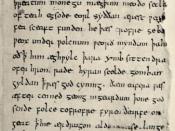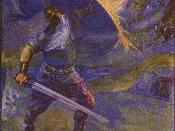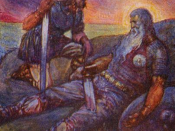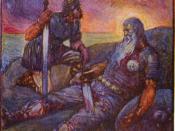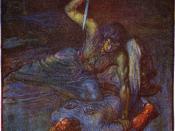"Beowulf" is an intensely violent and gruesome story. While this is an exceptionally graphic book, the author did not intend this to be a purely entertainment book; he wrote it as a didactic piece of literature (containing a moral message). Throughout the book, the author creates symbolism between his fictional characters and Biblical characters and between his fictional events and Biblical events. Beowulf is a Christian, didactic novel and therefore should be taught and discussed in all Christian schools.
Firstly, Beowulf's anonymous author centralized the hero in his story setting it apart from the majority of today's anti-hero stories. Many of the protagonists in modern books and movies do not resemble a hero. Instead of setting a high standard for people, the modern anti-hero rather makes that reader or viewer feel comfortable right where they are. Beowulf, on the other hand, was no doubt heroic in everything he did.
He is portrayed as a perfect role model that is unrealistic for any man to match. He calls people up to a higher standard for courage, leadership, strength, and integrity.
Beowulf is full of symbolism. Beowulf, in most scenes, symbolizes Jesus Christ as he triumphs over the evil creatures such as Grendel, Grendel's mother, the dragon, and some of the other sea creatures he told about from his past. Not one of Beowulf's followers could deal any harm to Grendel in his attack on the town. The blades of this world cannot pierce his skin. Only Beowulf had the strength to tear off Grendel's arm. Then Grendel retreated, missing one arm and the side of his torso. Jesus did the same thing when He cast Lucifer out of heaven, and his days are numbered. Beowulf is symbolic of Jesus, and Grendel is symbolic of Satan mortally wounded by Jesus.
Then, Beowulf dove down deep under water to finish off Grendel and stop his enraged mother. After he had finished off both Grendel and his mother, he ascended to the surface with the sword hilt which blade melted away and the head of Grendel. The act of submerging underwater and rising to the surface again was symbolic of water-baptism.
Beowulf later set out with 12 followers with the intent to slay the dragon who had been angered. As they drew near the cave where the dragon dwelled, 11 followers ran away and hid. Only one, Wiglaf, remained steadfast and fought alongside of his leader. This is symbolic of Jesus his 12 disciples.
In the end, Beowulf slays the dragon only after he is mortally poisoned by the dragon and died soon after. He sacrificed himself to save the city because one person stole a golden goblet from the treasure room and angered the dragon. That person symbolized us as sinners and Beowulf is Jesus who sacrificed his very life to save us.
By implementing Beowulf to the literature curriculum in a Christian school, you reap the fruit of learning about what the author has already discovered in the Word of God. It doesn't make sense to 're-invent the wheel' by reading only from the scriptures and discovering principles that have already been uncovered in books such as Beowulf.
